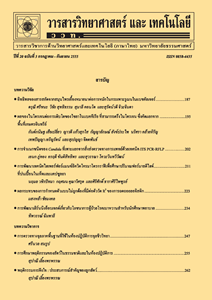การใช้ลิกไนต์และเชื้อเพลิงผสมระหว่างลิกไนต์กับกะลาปาล์มในหม้อไอน้ำ
Main Article Content
Abstract
บทคัดย่อ
โรงงานหลายแห่งได้นำชีวมวลมาผสมกับถ่านหินเพื่อเป็นการลดค่าใช้จ่าย โดยใช้ระบบการเผาไหม้และระบบบำบัดมลพิษทางอากาศที่มีอยู่เดิม เมื่อเปรียบเทียบค่าความร้อนลิกไนต์มีค่าความร้อนสูงกว่ากะลาปาล์ม กรณีที่นำเชื้อเพลิงทั้งสองมาผสมกัน สามารถประมาณค่าความร้อนของเชื้อเพลิงผสมได้ด้วยสมการเส้นตรง จากองค์ประกอบของเถ้านำไปหาแนวโน้มในการเกิด Slagging และ Fouling โดยใช้สมการ Alkaki Index (AI) และ Bed Agglomeration Index (BAI) พบว่าทั้งลิกไนต์และกะลาปาล์มมีแนวโน้มในการเกิด Slagging และ Fouling ทั้งนี้ผลการตรวจวัดมลพิษทางอากาศจากปล่องระบายอากาศเสียพบว่าเมื่อใช้ลิกไนต์เป็นเชื้อเพลิง ค่าความเข้มข้นฝุ่นละออง ก๊าซซัลเฟอร์ไดออกไซด์และก๊าซออกไซด์ของไนโตรเจนอยู่ในเกณฑ์มาตรฐาน แต่เมื่อใช้เชื้อเพลิงผสมระหว่างลิกไนต์และกะลาปาล์ม (80:20) ค่าความเข้มข้นฝุ่นละอองเกินมาตรฐาน จากแบบจำลอง METI-LIS (Ministry of Economy, Trade and Industry Low Rise Industrial Source Dispersion Model) พบว่าในกรณีใช้เชื้อเพลิงผสมจะมีการกระจายตัวของฝุ่นละอองกว้างกว่าการใช้เชื้อเพลิงลิกไนต์อย่างเดียว ซึ่งบริเวณดังกล่าวเป็นพื้นที่ทางการเกษตรทำให้มีผลกระทบต่อชุมชนไม่มากนัก ทั้งนี้ถ้าทางโรงงานจะใช้เชื้อเพลิงผสมต่อเนื่องควรจะเพิ่มประสิทธิภาพหรือติดตั้งระบบบำบัดฝุ่นละอองเพิ่มเติม เพื่อทำให้ค่าความเข้มข้นฝุ่นละอองอยู่ในระดับมาตรฐาน
คำสำคัญ : กะลาปาล์ม; slagging; fouling; ฝุ่นละออง; METI-LIS
Abstract
Many industries have been using a mixture of biomass and coal directly without any modifications of their combustion systems and pollution control devices. The heating value of lignite is slightly higher than that of palm-oil shell while the heating value of the mixed fuel could be predicted by using a linear equation. The oxide compositions of ash were analyzed and used to evaluate slagging and fouling propensity by empirical equations including alkali index (AI) and bed agglomeration index (BAI). It was found that the use of both lignite and palm-oil shell had a tendency to cause slagging and fouling problems. From the stack sampling, the concentration of particulate matter, sulfur dioxide and oxides of nitrogen met the emission standard when lignite was used as a fuel. However, the concentration of particulate matter exceeded the emission standard when the fuel used was the mixture of lignite and palm-oil shell with the ratio of 80 to 20 by weight. METI-LIS Model (Ministry of Economy, Trade and Industry Low Rise Industrial Source Dispersion Model) was used to evaluate the dispersion of emissions, especially particulate matter. Particulate matters from using lignite as a fuel spread wider than that from using the mixed fuel. However, the dispersion area was the agricultural site which might have lower impact to the nearby community. If the industry would like to use this mixed fuel, pollution control devices should be modified or new devices for particulate removal should be installed in order to meet the emission standard.
Keywords: palm-oil shell; slagging; fouling; particulate matters; METI-LIS


